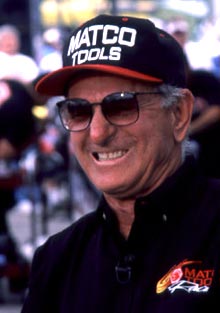|
 In
the meantime Garlits had already started to bring Swamp Rat 34 up to
current Top Fuel specs. The mono-strut had been previously certified
by NHRA with the 1250 square inch wing mounted to a max speed of 300
mph. Chassis builder Murf McKinney and NHRA ran separate engineering
studies and each came to the conclusion that the strut would handle
the new 1500 sq. inch wing and increased speed. There were also some
questions concerning how the rear-end was attached to the chassis. McKinney
made new stronger components for attaching the strut and the rear-end
to the car. In
the meantime Garlits had already started to bring Swamp Rat 34 up to
current Top Fuel specs. The mono-strut had been previously certified
by NHRA with the 1250 square inch wing mounted to a max speed of 300
mph. Chassis builder Murf McKinney and NHRA ran separate engineering
studies and each came to the conclusion that the strut would handle
the new 1500 sq. inch wing and increased speed. There were also some
questions concerning how the rear-end was attached to the chassis. McKinney
made new stronger components for attaching the strut and the rear-end
to the car.
Don Garlits has spent the money and time to get Swamp Rat 34 to conform
to NHRA and SFI chassis specs. According to Carl Olson of SFI, "The
chassis for Garlits' car and specifically how the mono-strut is mounted
and the rear-end attaches to the chassis was reviewed and approved by
the SFI chassis committee."
|
|
| In an accident such as this one involving
Jack Ostrander, the frame and attached tubes come under great stress. |
Ray Alley's main concern was and is using both lower frame rails for
fuel lines instead of plumbing fuel lines through the foot box, which
is the accepted standard. His concern is that in a crash the chassis
tubing could break, uprights could pull out of the lower frame rails,
or the rails themselves could be ground down until the tubing wall was
breached, allowing the fuel to escape and catch fire.
Garlits was, however, adamantly opposed to changing his fuel delivery
system by running fuel lines through the middle of the car and lobbied
NHRA both privately and publicly at the highest levels to allow him
to run the car with the fuel lines as they are. Perhaps fearing another
PR fiasco like the one that resulted when Garlits was left out of the
NHRA-backed drag racing history book, NHRA gave in and will allow Garlits
to race the car as is, using the lower frame rail as a fuel line despite
the fact that it isn't legal according to the 2002 rulebook.
Ray Alley explained why NHRA chose to do so. "We initially looked at
the fact that the car's lower frame rail carries the fuel and told him
he would have to fix it. We thought it would be a relatively low cost
project. However, it would actually be a very expensive and radical
fix."
In Garlits' car, because no fuel lines run through the foot box, the
driver's seat is mounted lower and the roll cage is lower than on a
conventional car. In order to route the fuel lines in the conventional
manner, the seat in the car would have to be remounted, the cage would
have to be completely rebuilt, and the canopy replaced. Rather than
force Garlits to re-route the fuel lines and radically change the car
and chassis, NHRA has given him permission to run the car as it now
is at three NHRA events this season.
|